

This is a list of foreign-born people who became samurai in Japan.


This is a list of foreign-born people who became samurai in Japan.
In this list, Japan means the Japanese archipelago. The word samurai has had a variety of meanings historically; here it is taken to mean 'those who serve in close attendance to the nobility'. This list includes the following people.
The following people are treated as "people who could be foreign-born samurai".
This list excludes the following people.

| Birthplace | Original name | Occupation before arrival in Japan | Year of arrival in Japan | Name in Japan | Lord | Occupation and achievements in Japan |
|---|---|---|---|---|---|---|
| (now | Kim Yeo-cheol (Kanji: 金如鐵) [5] | Son of 金時省, civil officer of Joseon [5] | 1592 [4] | Wakita Naokata 脇田直賢 [4] | Maeda Toshinaga→ Maeda Toshitsune [4] → Maeda Mitsutaka→ Maeda Tsunanori | 240 koku later increased to 1,000 koku. On-Koshōgashira (Head of pages). Kanazawa machi-bugyō (Commissioner of Kanazawa city). He served in the Summer Campaign of the Siege of Osaka. [4] |
| | unknown [6] | Son of 曽清官, commanding officer of Joseon [6] | 1598 [6] | Soga Seikan 曾我清官 [6] | Nakagawa Hidenari [6] | 150 koku. Page of Hidenari. [6] |
| | (Kanji:李聖賢) [7] | Son of Yi Bok-nam, commander of Joseon [7] | 1598 [7] | Rinoie Motohiro 李家元宥 [7] | Mōri Terumoto→ Mōri Hidenari [7] | 100 koku. Adviser of Mori clan. He was the swordsman who received menkyo of Yagyū Shinkage-ryū. [7] |
| | Jan Joosten van Lodensteijn | Mate of De Liefde, Dutch ship [8] | 1600 [9] | Yayōsu 耶楊子 | Tokugawa Ieyasu→ Tokugawa Hidetada | 100 koku. He was given the rank of Hatamoto and 50 servants. [8] [10] Under the Tokugawa Shogunate, he chartered several Red Seal Ships. |
| | William Adams | Pilot of De Liefde, Dutch ship [8] | 1600 [9] | Miura Anjin (the pilot of Miura) 三浦按針 | Tokugawa Ieyasu→ Tokugawa Hidetada | 250 koku. [8] [11] He was granted the rank of Hatamoto, a fief and 80-90 servants. Interpreter and shipwright of Tokugawa Shogunate. (Adams was the model for the character John Blackthorne in James Clavell's novel Shōgun (1975).) |
| | unknown | unknown | unknown | Yagyū Shume 柳生主馬 [12] | Yagyū Munenori [12] → Yagyū "Jūbei" Mitsuyoshi→ Yagyū Munefuyu | Retainer of Yagyū clan. 200 koku? [13] He married the sister of Yagyū "Hyōgonosuke" Toshitoshi. [7] |
| (now | (Kanji:藍會榮) [15] | The member of the inner circle of Ming dynasty [15] | After 1624 [15] | Kawaminami Genbei (First) 河南源兵衛 [15] | Shimazu Iehisa [15] | 300 koku. He was political refugee from Ming. Tōtsūji (Chinese translator) of Satsuma domain. He was given right to wear swords. [15] |
| | Giuseppe Chiara [16] | Jesuit missionary | 27 June 1643 | Okamoto San'emon 岡本三右衛門 | Tokugawa Iemitsu→ Tokugawa Ietsuna | He was given 10 servants and lived in Japan advising the Shogunate on European affairs until his death in 1685. Was one of the inspirations for Martin Scorsese's Silence . |
| | Henry Schnell [17] | Soldier and arms dealer | 1860s | Hiramatsu Buhei 平松武兵衛 | Matsudaira Katamori | Served the Aizu domain as a military instructor and procurer of weapons. Given the right to wear swords, a mansion in the castle town of Wakamatsu and retainers. |
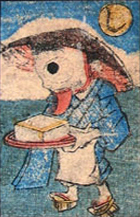
Hitotsume-kozō (一つ目小僧) are a Yōkai of Japan that take on the appearance of a bald-headed child with one eye in the center of its forehead similar to a cyclops.
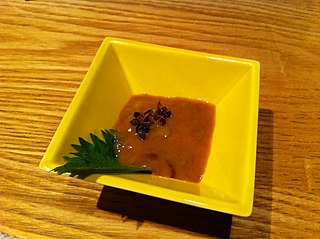
Konowata is a kind of shiokara, made from sea cucumber intestines. Along with sea urchin and karasumi, it is one of Japan's three Chinmi.

Kasa-obake are a mythical ghost or yōkai in Japanese folklore. They are sometimes, but not always, considered a tsukumogami that old umbrellas turn into. They are also called "karakasa-obake" (から傘おばけ), "kasa-bake" (傘化け), and "karakasa kozō" (唐傘小僧).

The bakeneko is a type of Japanese yōkai, or supernatural entity; more specifically, it is a kaibyō, or supernatural cat. It is often confused with the nekomata, another cat-like yōkai. The distinction between them is often ambiguous, but the largest difference is that the nekomata has two tails, while the bakeneko has only one.
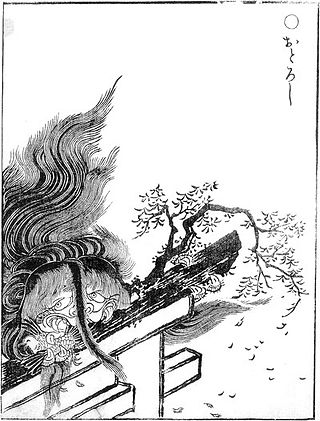
Otoroshi are a Japanese yōkai that appear in several yōkai emaki, such as the Hyakkai Zukan by Sawaki Suushi and the Gazu Hyakki Yagyō by Toriyama Sekien (1776).

Mikoshi-nyūdō is a type of bald-headed yōkai "goblin" with an ever-extending neck. In Japanese folklore and Edo period (1603–1868) kaidan "ghost story" texts, mikoshi-nyūdō will frighten people who look over the top of things such as byōbu folding screens. The name combines mikoshi見越し "looking over the top ; anticipation; expectation" and nyūdō入道 "a (Buddhist) priest; a bonze; a tonsured monster".
Kenichi Ara is a Japanese political commentator and researcher on modern history. Until the 1980s, he used the pen name Hideo Hatakenaka.

The kasha is a Japanese yōkai that steals the corpses of those who have died as a result of accumulating evil deeds.

Danzaburou-danuki is a bake-danuki passed down in stories on Sado Island, particularly in Aikawa and Niigata. In Sado, tanuki were called "mujina (狢)", thus he was also referred to as Danzaburou-mujina (団三郎狢). In the Ukiyo-e, its name was written as 同三狸." Together with the Shibaemon-tanuki of Awaji Island, and the Yashima no Hage-tanuki of Kagawa, they form the "three famous tanuki" of Japan.
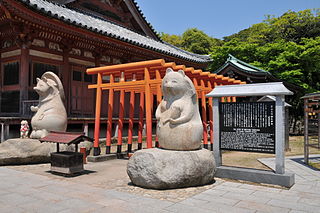
Yashima no Hage-tanuki (屋島の禿狸) is a Bake-danuki, who appears in the legends of Yashima, Takamatsu, Kagawa Prefecture. He is also called Tasaburō-tanuki (太三郎狸), Yashima no Hage, and Yashima no Kamuro (屋島の禿). He is counted as one of the "three famous tanuki of Japan", along with Danzaburou-danuki of Sado and Shibaemon-tanuki of Awaji. He is also famous due to his appearance in the Studio Ghibli animated movie, Heisei Tanuki Gassen Ponpoko.
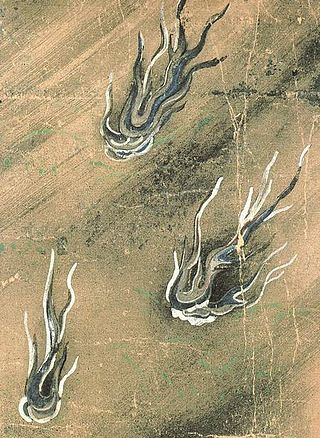
Kitsunebi (狐火) is an atmospheric ghost light told about in legends all across Japan outside Okinawa Prefecture. They are also called "hitobosu", "hitomoshi" (火点し), and "rinka" (燐火).
Misaki are a collective term for spirit-like existences in Japan like gods, demons and spirits, among other supernatural entities. Their name comes from a kannushi's vanguard.

Yamajijii (山爺) or Yamachichi (山父) is a type of yōkai.
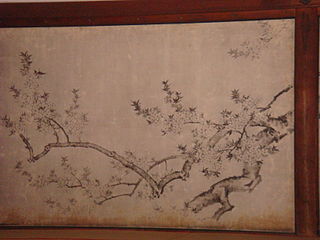
The Hara School was a Kyoto-based Japanese painting atelier established in the late Edo era, which continued as a family-controlled enterprise through the early 20th century. The Hara artists were imperial court painters and exerted great influence within Kyoto art circles. They contributed paintings to various temples and shrines, as well as to the Kyoto Imperial Palace.

Wakita Naokata, Korean name Kim Yŏ-ch'ŏl ; was a samurai from Joseon who served the Maeda clan in the early Edo period. He was one of the most successful samurai from Korea and was promoted to Commissioner of Kanazawa city.
This is a genealogical tree of the leaders of the Fujiwara clan from 669 to 1871, who were otherwise known as the Tōshi no Chōja.
Yagyū Shume was a Korean-born retainer who served Yagyū clan. Few records discuss his activity as a samurai. However, he is known as a central figure of the feud of Yagyū clan between Yagyū domain line from Yagyū Munenori and Owari domain line from Yagyū Toshitoshi.
The Order of Musashi Shinobi Samurai is a Japanese shinobisamurai clan which served Tokugawa Ieyasu and the Edo Shogunate from 1582 to 1868. They served the Tokugawa Shogunate as intelligence operatives called onmitsu, and metsuke (inspectors), and in the 19th century, as diplomats. When the political system changed due to the restoration of the monarchy in 1868, it became independent. The order consists of a number of families and people who have built close relations of trust with the Shibata Clan of the Musashi Province.
The term unity of religion and rule refers to the unification of ritual and politics. ritual in ritual-politics means "ritual" and religion. The word "politics" means "ritual" and politics.